Experimental data sets : Download the national work data set
import pandas as pd
import numpy as np
from pyecharts.charts import *
from pyecharts import options as opts
from pyecharts.commons.utils import JsCode
from pyecharts.globals import SymbolType
from pyecharts.components import Table
import textwrap
path = r'2022 Annual data analysis post recruitment data .csv'# Modify the file storage directory
data = pd.read_csv(path)
data.head()

# Urban data processing
data[' City '] = data[' place '].apply(lambda x:x.split('-')[0])
data.head()

# Salary data processing
# Remove non scope data
data2 = data[data[' salary range '] != ' Face to face discussion ']
data2 = data2[~data2. salary range .str.contains('/ God ')]
data2 = data2[~data2. salary range .str.contains(' following ')]
data2[' Salary floor '] = data2. salary range .apply(lambda x:x.split('-')[0])
data2[' Salary cap '] = data2. salary range .apply(lambda x:x.split('-')[1])
# Define a function to convert the salary into a numerical form
def salary_handle(word):
if word[-1] == ' ten thousand ':
num = float(word.strip(' ten thousand ')) * 10000
elif word[-1] == ' thousand ':
num = float(word.strip(' thousand ')) * 1000
return num
data2[' Salary floor '] = data2. Salary floor .apply(lambda x:salary_handle(x))
data2[' Salary cap '] = data2. Salary cap .apply(lambda x:salary_handle(x))
data2[' Average salary '] = round((data2. Salary cap + data2. Salary floor )/2,2)
data2.head()
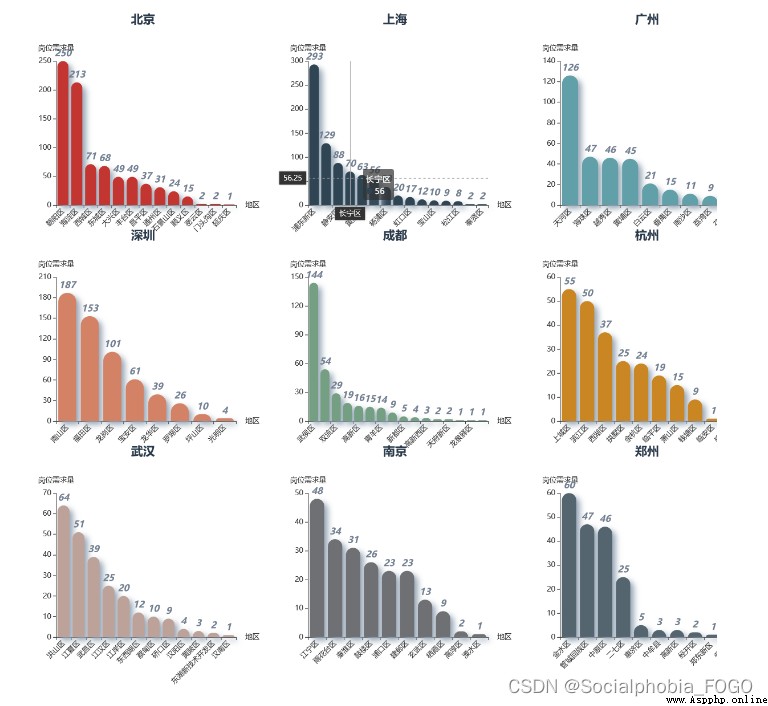
print(' The amount of nonstandard data is :',data.shape[0] - data2.shape[0])
The amount of nonstandard data is : 330
# Remove outliers
data2 = data2.reset_index(drop = True)
# data2[data2[' Work experience ']=='10 In the above ']
data2 = data2.drop(index = 5860)
In the data preprocessing part , Did the following .
First import the data , Check the basic data . Because the data is self crawling , So the data of each field is basically understood , This part is omitted .
Then process the city data . In the recruitment information released by the enterprise , Most of the information about the workplace is accurate to the specific urban area . Therefore, the cities in the work area are extracted here , Convenient for follow-up statistics .
Then process the salary range in the data . Because the data of salary range is ‘1 ten thousand -2 ten thousand ’ Or is it ‘7 thousand -9 thousand ’ Or is it ' Face to face discussion ' Or is it ‘200 element / God ’ Form like this , Therefore, you need to process salary data . View salary data , It is found that most of the salary data are based on ‘7 thousand -9 thousand ’ In the form of such a range , Only a small part of the data is ‘ Face to face discussion ’ Or is it ‘200/ God ’ Form like this , Such irregular data totals 330 strip , The proportion is not very large , Therefore, this part of data is directly removed . And will be in the scope of 7 thousand 、1 Data in the form of million are converted into specific numerical data , Facilitate subsequent statistical analysis . And take the average of the upper and lower salary limits as a new field for analysis .
Let's first look at , Which city has the most job demand for data analysis posts ?
Draw the job demand list of each city as follows .
# Draw fillet histogram function
def echarts_bar(x,y,title = ' Main title ',subtitle = ' Subtitle ',label = ' legend '):
""" x: Function is introduced to x Axis label data y: Function is introduced to y Axis data title: Main title subtitle: Subtitle label: legend """
bar = Bar(
init_opts=opts.InitOpts(
# bg_color='#080b30', # Set the background color
theme='shine', # Set the theme
width='1000px', # Set the width of the graph
height='700px' # Set the height of the graph
)
)
bar.add_xaxis(x)
bar.add_yaxis(label,y,
label_opts=opts.LabelOpts(is_show=True) # Show data or not
,category_gap="50%" # Column width setting
)
bar.reversal_axis()
bar.set_series_opts( # Custom chart styles
label_opts=opts.LabelOpts(
is_show=True,
position='right', # position The location of the label Optional 'top','left','right','bottom','inside','insideLeft','insideRight'
font_size=15,
color= '#333333',
font_weight = 'bolder', # font_weight The thickness of the text font 'normal','bold','bolder','lighter'
font_style = 'oblique', # font_style The style of the font , Optional 'normal','italic','oblique'
), # Whether to display data labels
itemstyle_opts={
"normal": {
"color": JsCode(
"""new echarts.graphic.LinearGradient(0, 0, 0, 1, [{ offset: 0,color: '#FC7D5D'} ,{offset: 1,color: '#C45739'}], false) """
), # Adjust the color gradient of the column
'shadowBlur': 6, # The size of light and shadow
"barBorderRadius": [100, 100, 100, 100], # Adjust the column fillet radian
"shadowColor": "#999999", # Adjust shadow color
'shadowOffsetY': 2,
'shadowOffsetX': 2, # Offset
}
}
)
bar.set_global_opts(
# Title Setting
title_opts=opts.TitleOpts(
title=title, # Main title
subtitle=subtitle, # Subtitle
pos_left='center', # Title display position
title_textstyle_opts=opts.TextStyleOpts(color='#2C3B4C', font_size=20,font_weight='bolder')
),
# Legend settings
legend_opts=opts.LegendOpts(
is_show=True, # Show legend or not
pos_left='right', # Legend display location
pos_top='3%', # The distance from the top of the legend
orient='horizontal' # Legend horizontal layout
),
tooltip_opts=opts.TooltipOpts(
is_show=True, # Whether to use the prompt box
trigger='axis', # Trigger type
trigger_on='mousemove|click', # The trigger condition , Click or hover to start
axis_pointer_type='cross', # Type of indicator , Move the mouse to the chart area to view the effect
),
yaxis_opts=opts.AxisOpts(
is_show=True,
splitline_opts=opts.SplitLineOpts(is_show=False), # Split line
axistick_opts=opts.AxisTickOpts(is_show=False), # The scale does not show
axislabel_opts=opts.LabelOpts( # Axis label configuration
font_size=13, # font size
font_weight='bolder' # Word again
),
), # close Y Axis display
xaxis_opts=opts.AxisOpts(
boundary_gap=True, # There is no space on both sides
axistick_opts=opts.AxisTickOpts(is_show=True), # The scale does not show
splitline_opts=opts.SplitLineOpts(is_show=False), # Split lines are not displayed
axisline_opts=opts.AxisLineOpts(is_show=True), # The axis doesn't show
axislabel_opts=opts.LabelOpts( # Axis label configuration
font_size=13, # font size
font_weight='bolder' # Word again
),
),
)
return bar
job_demand = data2. City .value_counts().sort_values(ascending = True)
echarts_bar(job_demand.index.tolist(),job_demand.values.tolist(),title = ' Ranking of job demands of data analysis posts all over the country ',subtitle = ' ',
label = ' Job demand ').render_notebook()
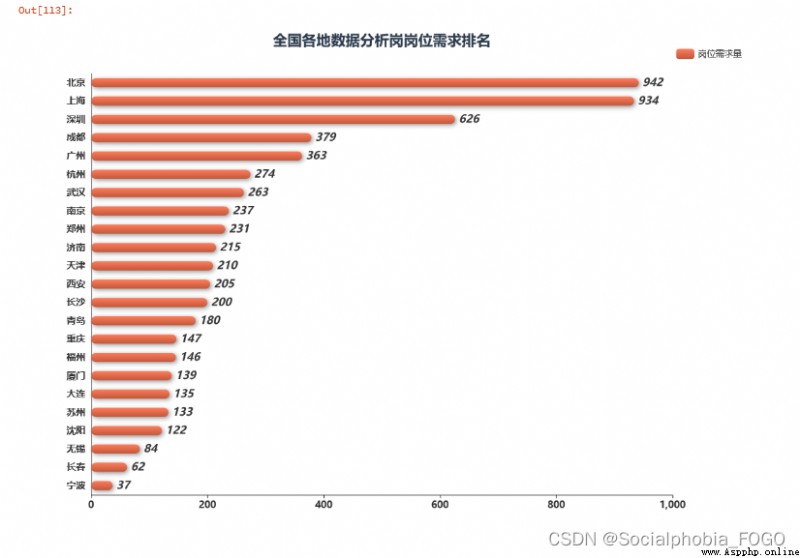 Through the ranking of post demand of data analysis posts all over the country, we can find , Beijing and Shanghai have the most job demand . Next is Shenzhen . Among the four first tier cities in Beijing, Shanghai, Guangzhou and Shenzhen , Guangzhou has the least demand for data analysis jobs . The demand for data analysis posts in Chengdu has increased rapidly in recent years , Even more than Guangzhou . Next is Hangzhou 、 wuhan 、 Nanjing and other cities .
Through the ranking of post demand of data analysis posts all over the country, we can find , Beijing and Shanghai have the most job demand . Next is Shenzhen . Among the four first tier cities in Beijing, Shanghai, Guangzhou and Shenzhen , Guangzhou has the least demand for data analysis jobs . The demand for data analysis posts in Chengdu has increased rapidly in recent years , Even more than Guangzhou . Next is Hangzhou 、 wuhan 、 Nanjing and other cities .
Therefore, you need to find a little partner who works in the data analysis post or internship , It is recommended to go to the first tier cities like Beijing, Shanghai, Guangzhou and Shenzhen .
Let's take a closer look at Beijing, Shanghai, Guangzhou, Shenzhen and Chengdu 、 Hangzhou and other data analysis Posts rank top in job demand 9 In the city , Where are the data analysis Posts mainly distributed .
# Job demand in Beijing, Shanghai, Guangzhou, Shenzhen, Chengdu and Hangzhou
beijing_demand = data[data[' City '] == ' Beijing '][' place '].value_counts().sort_values(ascending = False)
shanghai_demand = data[data[' City '] == ' Shanghai '][' place '].value_counts().sort_values(ascending = False)
shenzhen_demand = data[data[' City '] == ' Shenzhen '][' place '].value_counts().sort_values(ascending = False)
guangzhou_demand = data[data[' City '] == ' Guangzhou '][' place '].value_counts().sort_values(ascending = False)
chengdu_demand = data[data[' City '] == ' Chengdu '][' place '].value_counts().sort_values(ascending = False)
hangzhou_demand = data[data[' City '] == ' Hangzhou '][' place '].value_counts().sort_values(ascending = False)
def bar_chart(desc, title_pos):
df_t = data[(data[' City '] == desc)&(data[' place '] != desc)][' place '].value_counts().sort_values(ascending = False).reset_index()
df_t.columns = [desc,' Job demand ']
df_t[desc] = df_t[desc].apply(lambda x:x.split('-')[1])
# Create a new one Bar
chart = Bar(
init_opts=opts.InitOpts(
# bg_color='#2C3B4C', # Set the background color
theme='white', # Set the theme
width='400px', # Set the width of the graph
height='400px'
)
)
chart.add_xaxis(
df_t[desc].tolist()
)
chart.add_yaxis(
'',
df_t[' Job demand '].tolist()
)
chart.set_series_opts( # Custom chart styles
label_opts=opts.LabelOpts(
is_show=True,
position='top', # position The location of the label Optional 'top','left','right','bottom','inside','insideLeft','insideRight'
font_size=15,
color= '#727F91',
font_weight = 'bolder', # font_weight The thickness of the text font 'normal','bold','bolder','lighter'
font_style = 'oblique', # font_style The style of the font , Optional 'normal','italic','oblique'
), # Whether to display data labels
itemstyle_opts={
"normal": {
'shadowBlur': 10, # The size of light and shadow
"barBorderRadius": [100, 100, 0, 0], # Adjust the column fillet radian
"shadowColor": "#94A4B4", # Adjust shadow color
'shadowOffsetY': 6,
'shadowOffsetX': 6, # Offset
}
}
)
# Bar Global configuration items for
chart.set_global_opts(
xaxis_opts=opts.AxisOpts(
name=' region ',
is_scale=True,
axislabel_opts=opts.LabelOpts(rotate = 45),
# Grid line configuration
splitline_opts=opts.SplitLineOpts(
is_show=False,
linestyle_opts=opts.LineStyleOpts(
type_='dashed'))
),
yaxis_opts=opts.AxisOpts(
is_scale=True,
name=' Job demand ',
type_="value",
# Grid line configuration
splitline_opts=opts.SplitLineOpts(
is_show=False,
linestyle_opts=opts.LineStyleOpts(
type_='dashed'))
),
# Title Configuration
title_opts=opts.TitleOpts(
title=desc,
pos_left=title_pos[0],
pos_top=title_pos[1],
title_textstyle_opts=opts.TextStyleOpts(color='#2C3B4C', font_size=20)
),
tooltip_opts=opts.TooltipOpts(
is_show=True, # Whether to use the prompt box
trigger='axis', # Trigger type
# is_show_content = True,
trigger_on='mousemove|click', # The trigger condition , Click or hover to start
axis_pointer_type='cross', # Type of indicator , Move the mouse to the chart area to view the effect
),
)
return chart
grid = Grid(
init_opts=opts.InitOpts(
theme='white',
width='1200px',
height='1200px',
)
)
# Add price comparison under different attributes in turn Bar
grid.add(
bar_chart(' Beijing ', ['15%', '3%']),
# is_control_axis_index=False,
grid_opts=opts.GridOpts(
pos_top='10%', # Appoint Grid The position of the neutron diagram
pos_bottom='70%',
pos_left='5%',
pos_right='70%'
)
)
grid.add(
bar_chart(' Shanghai ', ['50%', '3%']),
# is_control_axis_index=False,
grid_opts=opts.GridOpts(
pos_top='10%',
pos_bottom='70%',
pos_left='40%',
pos_right='35%'
)
)
grid.add(
bar_chart(' Guangzhou ', ['85%', '3%']),
# is_control_axis_index=False,
grid_opts=opts.GridOpts(
pos_top='10%',
pos_bottom='70%',
pos_left='75%',
pos_right='0%'
)
)
grid.add(
bar_chart(' Shenzhen ', ['15%', '33%']),
# is_control_axis_index=False,
grid_opts=opts.GridOpts(
pos_top='40%',
pos_bottom='40%',
pos_left='5%',
pos_right='70%'
)
)
grid.add(
bar_chart(' Chengdu ', ['50%', '33%']),
# is_control_axis_index=False,
grid_opts=opts.GridOpts(
pos_top='40%',
pos_bottom='40%',
pos_left='40%',
pos_right='35%'
)
)
grid.add(
bar_chart(' Hangzhou ', ['85%', '33%']),
# is_control_axis_index=False,
grid_opts=opts.GridOpts(
pos_top='40%',
pos_bottom='40%',
pos_left='75%',
pos_right='0%'
)
)
grid.add(
bar_chart(' wuhan ', ['15%', '63%']),
# is_control_axis_index=False,
grid_opts=opts.GridOpts(
pos_top='70%',
pos_bottom='10%',
pos_left='5%',
pos_right='70%'
)
)
grid.add(
bar_chart(' nanjing ', ['50%', '63%']),
# is_control_axis_index=False,
grid_opts=opts.GridOpts(
pos_top='70%',
pos_bottom='10%',
pos_left='40%',
pos_right='35%'
)
)
grid.add(
bar_chart(' zhengzhou ', ['85%', '63%']),
# is_control_axis_index=False,
grid_opts=opts.GridOpts(
pos_top='70%',
pos_bottom='10%',
pos_left='75%',
pos_right='0%'
)
)
grid.render_notebook()

By drawing a histogram, we can find , Beijing is the city with the most job demand , Its data analysis posts are mainly distributed in Chaoyang District and Haidian District , Other districts have less than one-third of the job demand of these two districts .
Pudong New Area has the largest demand for data analysis posts in Shanghai , The second is Xuhui District , And the job demand of Xuhui District is less than half of that of Pudong New Area .
The demand for data analysis posts in Guangzhou is mainly distributed in Tianhe District , Haizhu Yuexiu Whampoa also has some data analysis posts , But the most important thing is re Tianhe District .
The demand for data analysis posts in Shenzhen is mainly distributed in Nanshan District 、 Futian District and Longgang District .
…
Let's take a look at the issues that most of my friends are concerned about , Is the salary level . The calculation here adopts the average value of the salary range of recruitment published by the enterprise .
city_salary = data2[[' City ',' Average salary ']].groupby(' City ').mean().round(0).sort_values(by = ' Average salary ',ascending = True).reset_index()
echarts_bar(city_salary[' City '].tolist(),city_salary[' Average salary '].tolist(),title = ' Ranking of average salary level of data analysis posts in cities across the country ',
subtitle = '',label = ' Average salary ').render_notebook()
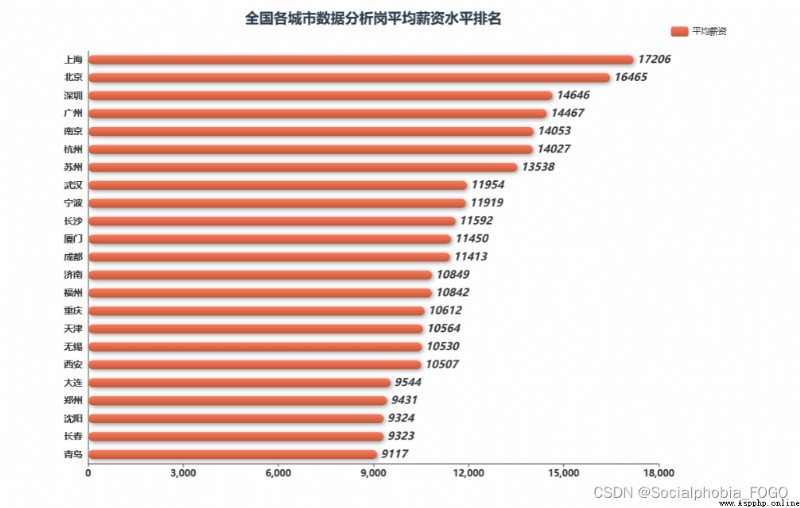
Looking at the salary level of each city, you can find , Beijing, Shanghai, Guangzhou and Shenzhen are the four first tier cities with the most developed economy , The salary level is also the highest . The city with the highest salary for data analysis post is Shanghai , Among the four cities, Guangzhou has the lowest salary . The salaries of Nanjing and Suzhou and Hangzhou followed closely , It is worth mentioning that , Chengdu, where the demand for jobs exceeds that of Guangzhou , The salary level is in the middle level .
After knowing which city has a higher salary level , Let's take a look at the distribution of salary levels for different work experiences and different degrees
# Different degrees 、 Different experiences 、 junior college - Cross analysis of different experiences 、 Undergraduate - Cross analysis of different experiences 、 master - Cross analysis of different experiences 、 Education is unlimited - Cross analysis of different experiences
job_exp = data2[[' Work experience ',' Average salary ']].groupby(' Work experience ').mean().round(0).sort_values(by = ' Average salary ',ascending = False).reset_index()
job_edu = data2[[' Degree required ',' Average salary ']].groupby(' Degree required ').mean().round(0).sort_values(by = ' Average salary ',ascending = False).reset_index()
benke_exp = data2[data2[' Degree required '] == ' Undergraduate '][[' Work experience ',' Average salary ']].groupby(' Work experience ').mean().round(0).\
sort_values(by = ' Average salary ',ascending = False).reset_index()
dazhuan_exp = data2[data2[' Degree required '] == ' junior college '][[' Work experience ',' Average salary ']].groupby(' Work experience ').mean().round(0).\
sort_values(by = ' Average salary ',ascending = False).reset_index()
shuoshi_exp = data2[data2[' Degree required '] == ' master '][[' Work experience ',' Average salary ']].groupby(' Work experience ').mean().round(0).\
sort_values(by = ' Average salary ',ascending = False).reset_index()
buxian_exp = data2[data2[' Degree required '] == ' Education is unlimited '][[' Work experience ',' Average salary ']].groupby(' Work experience ').mean().round(0).\
sort_values(by = ' Average salary ',ascending = False).reset_index()
boshi_exp = data2[data2[' Degree required '] == ' Doctor '][[' Work experience ',' Average salary ']].groupby(' Work experience ').mean().round(0).\
sort_values(by = ' Average salary ',ascending = False).reset_index()
gaozhong_exp = data2[data2[' Degree required '] == ' high school '][[' Work experience ',' Average salary ']].groupby(' Work experience ').mean().round(0).\
sort_values(by = ' Average salary ',ascending = False).reset_index()
zhongzhuan_exp = data2[data2[' Degree required '] == ' secondary specialized school / Zhongji '][[' Work experience ',' Average salary ']].groupby(' Work experience ').mean().round(0).\
sort_values(by = ' Average salary ',ascending = False).reset_index()
def bar_chart2(x,y,title_pos,title = ' Main title ',subtitle = ' Subtitle '):
# Create a new one Bar
chart = Bar(
init_opts=opts.InitOpts(
# bg_color='#2C3B4C', # Set the background color
theme='white', # Set the theme
width='400px', # Set the width of the graph
height='400px'
)
)
chart.add_xaxis(
x
)
chart.add_yaxis(
'',
y
)
chart.set_series_opts( # Custom chart styles
label_opts=opts.LabelOpts(
is_show=True,
position='top', # position The location of the label Optional 'top','left','right','bottom','inside','insideLeft','insideRight'
font_size=15,
color= '#727F91',
font_weight = 'bolder', # font_weight The thickness of the text font 'normal','bold','bolder','lighter'
font_style = 'oblique', # font_style The style of the font , Optional 'normal','italic','oblique'
), # Whether to display data labels
itemstyle_opts={
"normal": {
'shadowBlur': 10, # The size of light and shadow
"barBorderRadius": [100, 100, 0, 0], # Adjust the column fillet radian
"shadowColor": "#94A4B4", # Adjust shadow color
'shadowOffsetY': 6,
'shadowOffsetX': 6, # Offset
}
}
)
# Bar Global configuration items for
chart.set_global_opts(
xaxis_opts=opts.AxisOpts(
name=' ',
is_scale=True,
axislabel_opts=opts.LabelOpts(rotate = 45),
# Grid line configuration
splitline_opts=opts.SplitLineOpts(
is_show=False,
linestyle_opts=opts.LineStyleOpts(
type_='dashed'))
),
yaxis_opts=opts.AxisOpts(
is_scale=True,
name=' Average salary ',
type_="value",
# Grid line configuration
splitline_opts=opts.SplitLineOpts(
is_show=False,
linestyle_opts=opts.LineStyleOpts(
type_='dashed'))
),
# Title Configuration
title_opts=opts.TitleOpts(
title=title,
subtitle = subtitle,
pos_left=title_pos[0],
pos_top=title_pos[1],
title_textstyle_opts=opts.TextStyleOpts(color='#2C3B4C', font_size=20)
),
tooltip_opts=opts.TooltipOpts(
is_show=True, # Whether to use the prompt box
trigger='axis', # Trigger type
# is_show_content = True,
trigger_on='mousemove|click', # The trigger condition , Click or hover to start
axis_pointer_type='cross', # Type of indicator , Move the mouse to the chart area to view the effect
),
)
return chart
grid = Grid(
init_opts=opts.InitOpts(
theme='white',
width='1200px',
height='1200px',
)
)
# Add price comparison under different attributes in turn Bar
grid.add(
bar_chart2(job_exp[' Work experience '].tolist(), job_exp[' Average salary '].tolist(), ['15%', '3%'], title=' Salary comparison of different work experience ',
subtitle=' '),
grid_opts=opts.GridOpts(
pos_top='10%', # Appoint Grid The position of the neutron diagram
pos_bottom='70%',
pos_left='5%',
pos_right='70%'
)
)
grid.add(
bar_chart2(job_edu[' Degree required '].tolist(), job_edu[' Average salary '].tolist(), ['50%', '3%'], title=' Salary comparison of different education requirements ',
subtitle=' '),
grid_opts=opts.GridOpts(
pos_top='10%',
pos_bottom='70%',
pos_left='40%',
pos_right='35%'
)
)
grid.add(
bar_chart2(buxian_exp[' Work experience '].tolist(), buxian_exp[' Average salary '].tolist(), ['85%', '3%'], title=' Education is unlimited ',
subtitle=' '),
grid_opts=opts.GridOpts(
pos_top='10%',
pos_bottom='70%',
pos_left='75%',
pos_right='0%'
)
)
grid.add(
bar_chart2(dazhuan_exp[' Work experience '].tolist(), dazhuan_exp[' Average salary '].tolist(), ['15%', '33%'], title=' junior college ',
subtitle=' '),
grid_opts=opts.GridOpts(
pos_top='40%',
pos_bottom='40%',
pos_left='5%',
pos_right='70%'
)
)
grid.add(
bar_chart2(benke_exp[' Work experience '].tolist(), benke_exp[' Average salary '].tolist(), ['50%', '33%'], title=' Undergraduate ',
subtitle=' '),
grid_opts=opts.GridOpts(
pos_top='40%',
pos_bottom='40%',
pos_left='40%',
pos_right='35%'
)
)
grid.add(
bar_chart2(shuoshi_exp[' Work experience '].tolist(), shuoshi_exp[' Average salary '].tolist(), ['85%', '33%'], title=' master ',
subtitle=' '),
grid_opts=opts.GridOpts(
pos_top='40%',
pos_bottom='40%',
pos_left='75%',
pos_right='0%'
)
)
grid.add(
bar_chart2(boshi_exp[' Work experience '].tolist(), boshi_exp[' Average salary '].tolist(), ['15%', '63%'], title=' Doctor ',
subtitle=' '),
grid_opts=opts.GridOpts(
pos_top='70%',
pos_bottom='10%',
pos_left='5%',
pos_right='70%'
)
)
grid.add(
bar_chart2(gaozhong_exp[' Work experience '].tolist(), gaozhong_exp[' Average salary '].tolist(), ['50%', '63%'], title=' high school ',
subtitle=' '),
grid_opts=opts.GridOpts(
pos_top='70%',
pos_bottom='10%',
pos_left='40%',
pos_right='35%'
)
)
grid.add(
bar_chart2(zhongzhuan_exp[' Work experience '].tolist(), zhongzhuan_exp[' Average salary '].tolist(), ['85%', '63%'], title=' secondary specialized school / Zhongji ',
subtitle=' '),
grid_opts=opts.GridOpts(
pos_top='70%',
pos_bottom='10%',
pos_left='75%',
pos_right='0%'
)
)
grid.render_notebook()
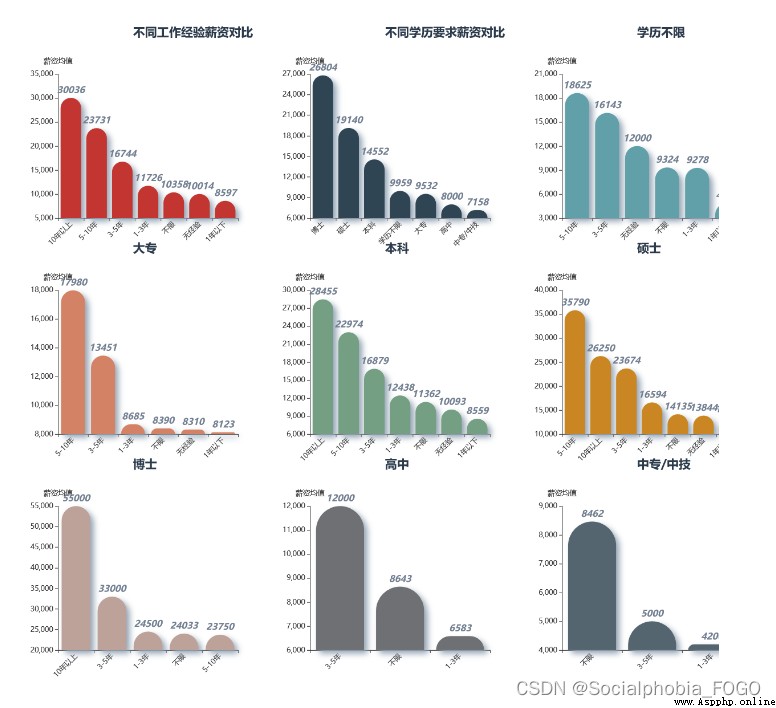
On the whole, work experience 、 The relationship between education and salary , You can find , The higher the work experience and educational background , The corresponding salary is higher , There is no doubt that .
Through different educational background , Cross analysis of different work experience and salary , It's not hard to see. , The higher academic qualifications , The corresponding salary has a higher rising space .
def bar_chart(desc, title_pos):
df_t = data2[data2[' City '] == desc][[' Work experience ',' Average salary ']].groupby(' Work experience ').mean().round(0).sort_values(by = ' Average salary ',
ascending = False).reset_index()
# Create a new one Bar
chart = Bar(
init_opts=opts.InitOpts(
# bg_color='#2C3B4C', # Set the background color
theme='white', # Set the theme
width='400px', # Set the width of the graph
height='400px'
)
)
chart.add_xaxis(
df_t[' Work experience '].tolist()
)
chart.add_yaxis(
'',
df_t[' Average salary '].tolist()
)
chart.set_series_opts( # Custom chart styles
label_opts=opts.LabelOpts(
is_show=True,
position='top', # position The location of the label Optional 'top','left','right','bottom','inside','insideLeft','insideRight'
font_size=15,
color= '#727F91',
font_weight = 'bolder', # font_weight The thickness of the text font 'normal','bold','bolder','lighter'
font_style = 'oblique', # font_style The style of the font , Optional 'normal','italic','oblique'
), # Whether to display data labels
itemstyle_opts={
"normal": {
'shadowBlur': 10, # The size of light and shadow
"barBorderRadius": [100, 100, 0, 0], # Adjust the column fillet radian
"shadowColor": "#94A4B4", # Adjust shadow color
'shadowOffsetY': 6,
'shadowOffsetX': 6, # Offset
}
}
)
# Bar Global configuration items for
chart.set_global_opts(
xaxis_opts=opts.AxisOpts(
name=' Work experience ',
is_scale=True,
axislabel_opts=opts.LabelOpts(rotate = 45),
# Grid line configuration
splitline_opts=opts.SplitLineOpts(
is_show=False,
linestyle_opts=opts.LineStyleOpts(
type_='dashed'))
),
yaxis_opts=opts.AxisOpts(
is_scale=True,
name=' Average salary ',
type_="value",
# Grid line configuration
splitline_opts=opts.SplitLineOpts(
is_show=False,
linestyle_opts=opts.LineStyleOpts(
type_='dashed'))
),
# Title Configuration
title_opts=opts.TitleOpts(
title=desc,
pos_left=title_pos[0],
pos_top=title_pos[1],
title_textstyle_opts=opts.TextStyleOpts(color='#2C3B4C', font_size=20)
),
tooltip_opts=opts.TooltipOpts(
is_show=True, # Whether to use the prompt box
trigger='axis', # Trigger type
# is_show_content = True,
trigger_on='mousemove|click', # The trigger condition , Click or hover to start
axis_pointer_type='cross', # Type of indicator , Move the mouse to the chart area to view the effect
),
)
return chart
grid = Grid(
init_opts=opts.InitOpts(
theme='white',
width='1200px',
height='1200px',
)
)
# Add price comparison under different attributes in turn Bar
grid.add(
bar_chart(' Beijing ', ['15%', '3%']),
# is_control_axis_index=False,
grid_opts=opts.GridOpts(
pos_top='10%', # Appoint Grid The position of the neutron diagram
pos_bottom='70%',
pos_left='5%',
pos_right='70%'
)
)
grid.add(
bar_chart(' Shanghai ', ['50%', '3%']),
# is_control_axis_index=False,
grid_opts=opts.GridOpts(
pos_top='10%',
pos_bottom='70%',
pos_left='40%',
pos_right='35%'
)
)
grid.add(
bar_chart(' Guangzhou ', ['85%', '3%']),
# is_control_axis_index=False,
grid_opts=opts.GridOpts(
pos_top='10%',
pos_bottom='70%',
pos_left='75%',
pos_right='0%'
)
)
grid.add(
bar_chart(' Shenzhen ', ['15%', '33%']),
# is_control_axis_index=False,
grid_opts=opts.GridOpts(
pos_top='40%',
pos_bottom='40%',
pos_left='5%',
pos_right='70%'
)
)
grid.add(
bar_chart(' Chengdu ', ['50%', '33%']),
# is_control_axis_index=False,
grid_opts=opts.GridOpts(
pos_top='40%',
pos_bottom='40%',
pos_left='40%',
pos_right='35%'
)
)
grid.add(
bar_chart(' Hangzhou ', ['85%', '33%']),
# is_control_axis_index=False,
grid_opts=opts.GridOpts(
pos_top='40%',
pos_bottom='40%',
pos_left='75%',
pos_right='0%'
)
)
grid.add(
bar_chart(' wuhan ', ['15%', '63%']),
# is_control_axis_index=False,
grid_opts=opts.GridOpts(
pos_top='70%',
pos_bottom='10%',
pos_left='5%',
pos_right='70%'
)
)
grid.add(
bar_chart(' nanjing ', ['50%', '63%']),
# is_control_axis_index=False,
grid_opts=opts.GridOpts(
pos_top='70%',
pos_bottom='10%',
pos_left='40%',
pos_right='35%'
)
)
grid.add(
bar_chart(' zhengzhou ', ['85%', '63%']),
# is_control_axis_index=False,
grid_opts=opts.GridOpts(
pos_top='70%',
pos_bottom='10%',
pos_left='75%',
pos_right='0%'
)
)
grid.render_notebook()
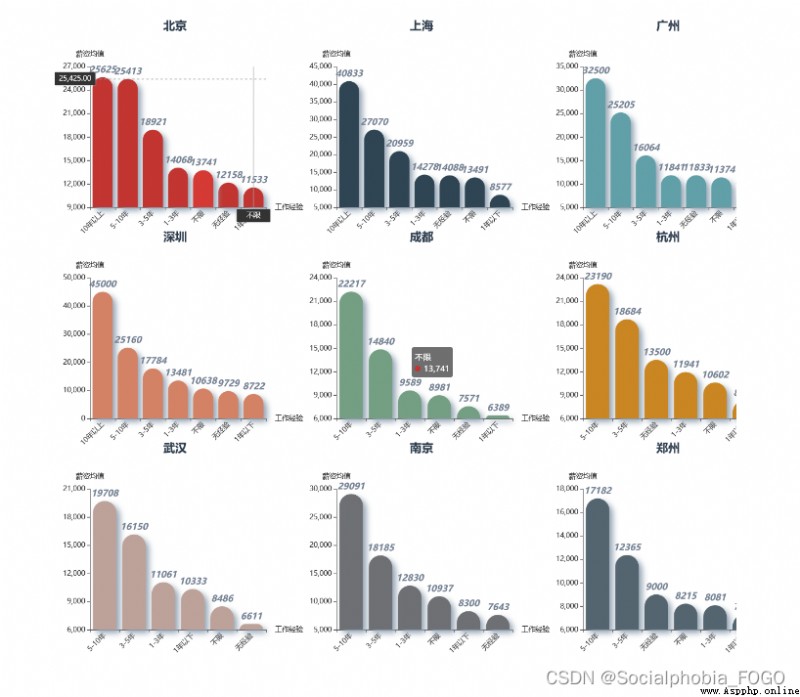
Look at the corresponding lower and upper salary limits in each city , You can find , The lower limit and upper limit of Beijing, Shanghai, Guangzhou and Shenzhen are very high , It's OK to go to the first tier cities for data analysis ~
After knowing the salary , Next, let's take a look at the job requirements of the data analysis post ~
pie1 = data[[' Work experience ',' Job title ']].groupby(' Work experience ').count().sort_values(by = ' Job title ',ascending = False).reset_index()
pie2 = data[[' Degree required ',' Job title ']].groupby(' Degree required ').count().sort_values(by = ' Job title ',ascending = False).reset_index()
pie1 = (Pie()
.add('', [list(z) for z in zip(pie1[' Work experience '], pie1[' Job title '])])
.set_global_opts(
title_opts=opts.TitleOpts(
title=' Work experience demand ',
title_textstyle_opts=opts.TextStyleOpts(color='#2C3B4C', font_size=20)
)
)
)
pie2 = (Pie()
.add('', [list(z) for z in zip(pie2[' Degree required '], pie2[' Job title '])])
.set_global_opts(
title_opts=opts.TitleOpts(
title=' Educational requirements ',
title_textstyle_opts=opts.TextStyleOpts(color='#2C3B4C', font_size=20)
)
)
)
page = Page()
page.add(pie1,pie2)
page.render_notebook()
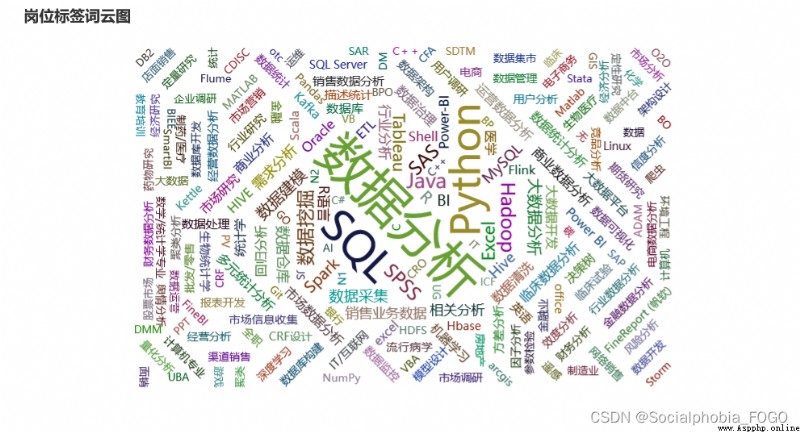
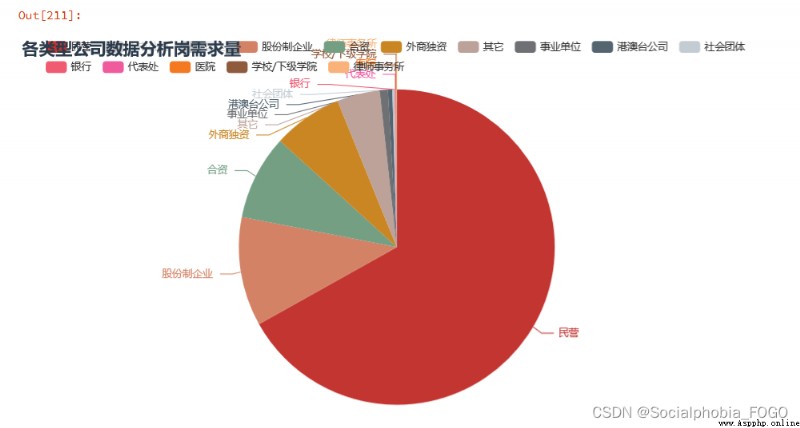
First, work experience . The data analysis post is above the requirements of work experience ,1-3 Years of work experience is the most , Not limited to work experience and 3-5 The demand for years of work experience is also relatively large .
Above the educational requirements , Undergraduate and junior colleges account for the vast majority , Only a few require master's and doctoral degrees . Therefore, the requirements of the data analysis post for academic qualifications are not very high .
Next, let's take a look at what skills the data analysis post should have ~
The data here is crawled from the position tag in the position information released by the company , Not the position JD
tag_array = data[' Job label '].apply(lambda x:eval(x)).tolist()
tag_lis = []
for tag in tag_array:
tag_lis += tag
tag_df = pd.DataFrame(tag_lis,columns = [' Position label '])
tag_df_cnt = tag_df[' Position label '].value_counts().reset_index()
tag_df_cnt.columns = [' Position label ',' Count ']
word_cnt_lis = [tag for tag in zip(tag_df_cnt[' Position label '],tag_df_cnt[' Count '])]
wc = (
WordCloud()
.add("",
word_cnt_lis,
)
.set_global_opts(
title_opts=opts.TitleOpts(title=" Post label word cloud chart "),
)
)
wc.render_notebook()

By drawing a cloud of words, we can find , Among the numerous job labels , The most frequent occurrence is python and sql 了 , So it can be said that ,sql and python It is a necessary skill for data analysis post , Of course excel Skills are also used frequently in daily work .
Data mining in word cloud 、 Data cleaning 、SPSS、BI Some words such as tools also appear more , It also depends on the specific needs of each post .
Next, let's look at the enterprises that employ data analysis posts , What are the main types of enterprises , And the size of the company .
company_type_cnt = data[[' Company type ',' The company size ']].groupby(' Company type ').count().sort_values(by = ' The company size ',ascending = False).reset_index()
# Delete null
company_type_cnt = company_type_cnt.drop(index = 10)
company_type_cnt.columns = [' Company type ',' Number ']
company_size_cnt = data[[' Company type ',' The company size ']].groupby(' The company size ').count().sort_values(by = ' Company type ',ascending = False).reset_index()
company_size_cnt.columns = [' The company size ',' Number ']
pie1 = (Pie()
.add('', [list(z) for z in zip(company_type_cnt[' Company type '], company_type_cnt[' Number '])])
.set_global_opts(
title_opts=opts.TitleOpts(
title=' Demand for data analysis posts of various types of companies ',
title_textstyle_opts=opts.TextStyleOpts(color='#2C3B4C', font_size=20)
)
)
)
pie2 = (Pie()
.add('', [list(z) for z in zip(company_size_cnt[' The company size '], company_size_cnt[' Number '])])
.set_global_opts(
title_opts=opts.TitleOpts(
title=' Demand for data analysis posts in companies of all sizes ',
title_textstyle_opts=opts.TextStyleOpts(color='#2C3B4C', font_size=20)
)
)
)
page = Page()
page.add(pie1,pie2)
page.render_notebook()

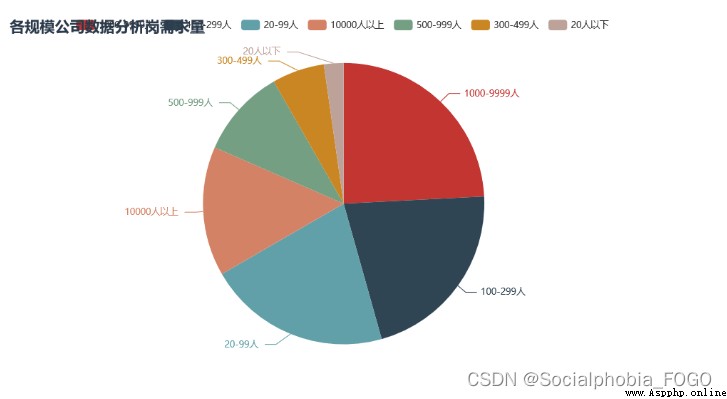
We can find out , Enterprises that recruit data analysis posts , Mainly private enterprises , More than half of them .
The scale of the company is 1000-9999 as well as 10000 Large-scale enterprises with more than employees are mainly , The digital construction of large factories is relatively complete and mature , Therefore, there will be more data analysis requirements . There are also some small and medium-sized enterprises , It may be some outsourcing enterprises .
Next , We calculate the salary top front 50 The enterprise , I hope it can provide some reference for you ~
company_rank = data2[[' Job title ',' Corporate name ',' Average salary ',' The company size ']].groupby([' Corporate name ',' The company size ',' Job title ']).mean().\
sort_values(by = [' Average salary '],ascending = False).reset_index()
table = Table()
table_rows = [company_rank.iloc[i,:].tolist() for i in range(50)]
table.add(company_rank.columns.tolist(), table_rows)
table.render_notebook()
 The method of calculating the number of lines in large files with Python and its performance comparison
The method of calculating the number of lines in large files with Python and its performance comparison
How to use Python Quickly and
 unbtun中pip安裝pandas時報錯ModuleNotFoundError: No module named ‘_ctypes‘解決方法
unbtun中pip安裝pandas時報錯ModuleNotFoundError: No module named ‘_ctypes‘解決方法
在安裝pandas發現報錯ModuleNotFoundErr